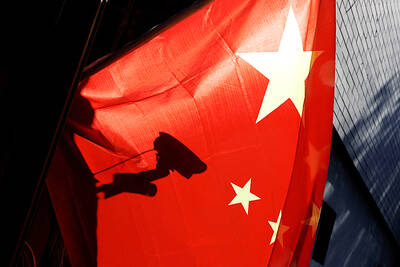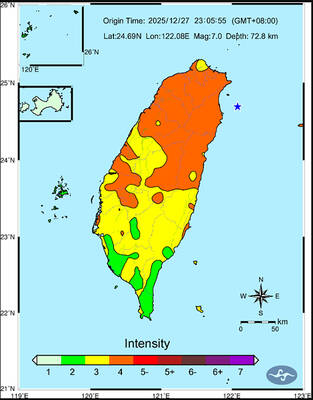In a military switch with direct implications for Taiwan, the Pentagon is changing the way it spies on China.
US General Gary North, Pacific Air Forces Commander, has announced that three Global Hawk drones — the US’ most advanced unmanned planes — are to be based at Anderson Air Force Base in Guam.
They are expected to start operating from Guam as soon as tomorrow.
North confirmed that the drones would gather intelligence and conduct surveillance and reconnaissance.
The Global Hawks will eventually take over completely from the U-2 spy planes and the RC-135 surveillance aircraft in the Asia-Pacific region.
These are the manned aircraft that currently fly high over the Taiwan Strait at regular intervals to monitor China’s missile buildup and the military forces facing Taiwan.
The spy planes — and now the drones — would probably provide the first major clues if China began moving towards an attack or invasion.
“The move to drones is definitely something for Taiwan to take note of. It’s a significant development,” said John Pike, head of the Washington-based think tank Global Security.
He said that it signaled Washington’s continued commitment to gathering intelligence in the region following the retirement of the U-2s and the RC-135s.
While it will take some months to establish that the drones can do as good a job as the manned spy planes, analysts believe they will provide a comparable service over the Taiwan Strait.
The drones do not fly as high as the spy planes, but will cover Chinese missile fields and bases in all of the coastal areas facing Taiwan.
Global Hawks can reach altitudes of 19km — well above the range of most defensive weapons — and can stay in the air for more than 32 hours at a time.
“It flies for more than a day and it flies at very good speeds and so you could transit a long distance,” North said.
While the exact figures are classified, it is believed that Global Hawks can fly about 16,000km on one mission.
The first of the three drones to be stationed on Guam arrived there earlier this month following an 18-hour journey from Beale Air Force Base in California.
Officially known as the RQ-4 Global Hawk, the drones are made by Northrop Grumman and cost about US$183 million each.
The drones have been described as having a “bulbous, whale-shaped nose” and have a top-mounted engine and V-tail. They are 13m long with a wingspan of 35m. Using information gathered by the spy plane program, the Pentagon reported this summer that China now has more than 1,400 missiles aimed at Taiwan and that despite much warmer economic relations “there have been no meaningful actions on the part of the mainland to reduce its military presence opposite the island.”
The Pentagon has concluded that with China’s rapidly expanding arsenal of ships, missiles and aircraft the cross-strait military balance continues to “shift in the mainland’s favor.”
With this in mind, US Representative Edward Royce told the US House of Representatives this week: “To help close the gap, Taiwan has had a pending request to buy additional F-16 fighter jets. The [US President Barack] Obama administration is still ‘studying’ this proposal.”
“Taiwan faces one of the most complex and lethal military threats in the world. Across the region, in response to China’s buildup and increasing assertiveness, China’s neighbors are moving to strengthen their security relationships with the US,” he said.
“This gravitation to the US will only last as long as the US is seen as a credible guarantor of stability. Moving forward with this F-16 sale would be an appropriate signal to Taiwan and the region. If we want cross-strait detente to succeed, Taiwan will have to operate from a position of strength,” Royce said.

A magnitude 7.0 earthquake struck off Yilan at 11:05pm yesterday, the Central Weather Administration (CWA) said. The epicenter was located at sea, about 32.3km east of Yilan County Hall, at a depth of 72.8km, CWA data showed There were no immediate reports of damage. The intensity of the quake, which gauges the actual effect of a seismic event, measured 4 in Yilan County area on Taiwan’s seven-tier intensity scale, the data showed. It measured 4 in other parts of eastern, northern and central Taiwan as well as Tainan, and 3 in Kaohsiung and Pingtung County, and 2 in Lienchiang and Penghu counties and 1

FOREIGN INTERFERENCE: Beijing would likely intensify public opinion warfare in next year’s local elections to prevent Lai from getting re-elected, the ‘Yomiuri Shimbun’ said Internal documents from a Chinese artificial intelligence (AI) company indicated that China has been using the technology to intervene in foreign elections, including propaganda targeting Taiwan’s local elections next year and presidential elections in 2028, a Japanese newspaper reported yesterday. The Institute of National Security of Vanderbilt University obtained nearly 400 pages of documents from GoLaxy, a company with ties to the Chinese government, and found evidence that it had apparently deployed sophisticated, AI-driven propaganda campaigns in Hong Kong and Taiwan to shape public opinion, the Yomiuri Shimbun reported. GoLaxy provides insights, situation analysis and public opinion-shaping technology by conducting network surveillance

‘POLITICAL GAME’: DPP lawmakers said the motion would not meet the legislative threshold needed, and accused the KMT and the TPP of trivializing the Constitution The Legislative Yuan yesterday approved a motion to initiate impeachment proceedings against President William Lai (賴清德), saying he had undermined Taiwan’s constitutional order and democracy. The motion was approved 61-50 by lawmakers from the main opposition Chinese Nationalist Party (KMT) and the smaller Taiwan People’s Party (TPP), who together hold a legislative majority. Under the motion, a roll call vote for impeachment would be held on May 19 next year, after various hearings are held and Lai is given the chance to defend himself. The move came after Lai on Monday last week did not promulgate an amendment passed by the legislature that

AFTERMATH: The Taipei City Government said it received 39 minor incident reports including gas leaks, water leaks and outages, and a damaged traffic signal A magnitude 7.0 earthquake struck off Taiwan’s northeastern coast late on Saturday, producing only two major aftershocks as of yesterday noon, the Central Weather Administration (CWA) said. The limited aftershocks contrast with last year’s major earthquake in Hualien County, as Saturday’s earthquake occurred at a greater depth in a subduction zone. Saturday’s earthquake struck at 11:05pm, with its hypocenter about 32.3km east of Yilan County Hall, at a depth of 72.8km. Shaking was felt in 17 administrative regions north of Tainan and in eastern Taiwan, reaching intensity level 4 on Taiwan’s seven-tier seismic scale, the CWA said. In Hualien, the